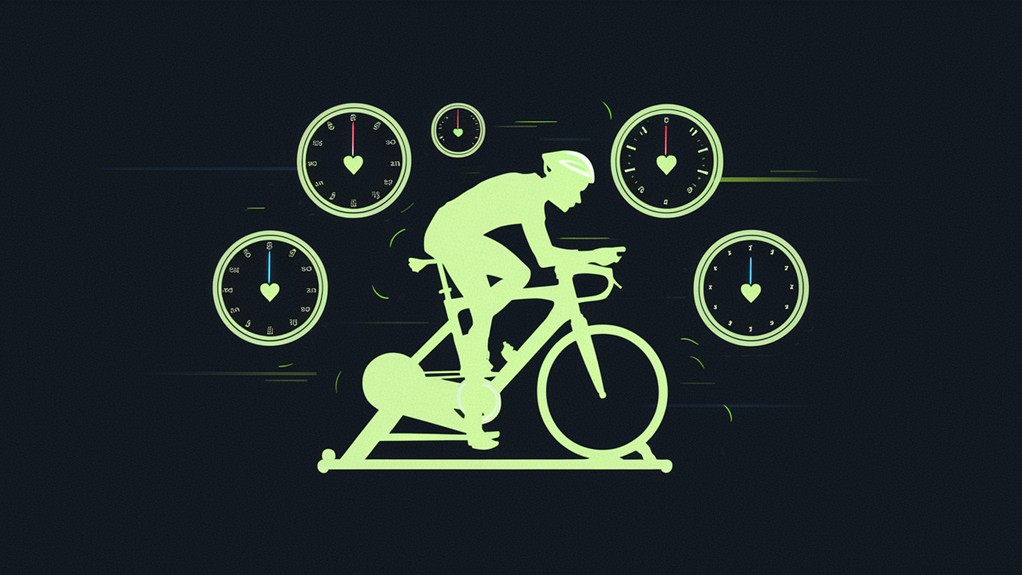Understanding RPE (Rate of Perceived Exertion) for turbo training is key to optimizing your workouts. The RPE scale, ranging from 1 to 10, allows you to gauge your effort level, from very light to near maximal exertion. By correlating your perceived exertion with specific training zones, you can fine-tune your sessions to meet your goals. For turbo training, aim for RPE 4-7 during warm-up and recovery, RPE 8 for main sets, and RPE 9-10 for high-intensity intervals. By incorporating RPE, you'll be able to adjust intensity in real-time, prevent injury, and improve mental resilience – and that's just the beginning of what you'll uncover as you investigate the benefits of RPE training.
RPE Scale Fundamentals
When you're on the bike, it's essential to understand the language of effort, and that's where the Rate of Perceived Exertion (RPE) scale comes in. One common RPE misconception is that it's only about how hard you're gasping or how fast your heart is racing. However, RPE is a subjective measure that allows you to gauge your exertion levels and adjust your training intensity accordingly, fostering self-awareness during workouts.
The RPE scale ranges from 1 to 10, with lower numbers indicating very light effort and higher numbers indicating maximal effort during exercise. For example, an RPE of 1-2 represents very light effort, while an RPE of 8-10 denotes high effort levels that are challenging and near maximal.
Understanding RPE helps you manage your pacing and energy during both training and competitive events, providing a flexible approach to effort monitoring.
The benefits of using RPE are numerous. It's particularly useful for cyclists and triathletes to correlate their perceived exertion with specific training zones, enhancing workout specificity.
Understanding Effort Levels
Five distinct effort levels fall within the RPE scale, each with its unique characteristics and implications for your turbo training.
Understanding these effort levels is vital to tailor your workouts effectively and achieve your goals.
- Very light effort (RPE 1-2): You're barely breaking a sweat, and conversations come easily.
- Moderate effort (RPE 5-6): You're working, but it's still manageable for longer periods.
- Moderate-high effort (RPE 7): It's challenging, but you can sustain it for a while, making it perfect for interval training.
- High effort (RPE 8-9): You're pushing yourself hard, but not quite at maximum exertion.
- Near maximal exertion (RPE 10): You're giving it your all, and it's extremely challenging to sustain.
Applying RPE in Turbo Training

Your turbo training sessions can become more effective and personalized by applying the RPE scale, allowing you to fine-tune your workouts and achieve specific goals.
To get started, consider the following guidelines for incorporating RPE into your turbo training:
| RPE | Effort Level | Training Zone |
|---|---|---|
| 4-7 | Warm-up/Recovery | Endurance Zone |
| 8 | Main Sets | Threshold Zone |
| 9-10 | High-Intensity Intervals | VO2 Max Zone |
Sample Workouts and RPE
Tailored workouts are essential for maximizing turbo training benefits, and incorporating RPE levels can assist you in achieving specific goals. By designing workouts that target specific intensities, you can confirm you're getting the most out of your turbo training sessions.
Here are some sample workouts that incorporate RPE levels:
- Warm up with 6 minutes at RPE 4-7, gradually increasing intensity before the main set.
- Complete 4×10 minutes at RPE 8, with 3 minutes of easy recovery between each interval to maintain performance.
- Finish with a 1-minute cool-down at RPE 4, effectively lowering your heart rate to approximately 55% of Functional Threshold Power (FTP).
- Try a workout that features a warm-up at RPE 4, a main effort at RPE 6, and a cool-down as well at RPE 4 for gradual recovery.
- Mix it up with interval training and workout variations that incorporate different RPE levels to improve specificity and effectiveness, allowing for tailored training adaptations across different cycling intensities.
Importance of RPE in Training

During turbo training, understanding the importance of RPE in your workout routine can be a game-changer, as it allows you to tap into the full potential of your training sessions. By incorporating RPE into your training, you'll experience numerous benefits that will take your performance to the next level.
| RPE Benefits | How You'll Benefit |
|---|---|
| Fosters self-awareness | Understand your physical limits and adapt your training accordingly |
| Encourages real-time adjustments | Make adjustments to your workout intensity based on daily performance variability |
| Promotes injury prevention | Avoid overtraining and burnout by exerting sensible effort |
| Improves mental resilience | Manage perceived effort to improve performance in training and competitive environments |
| Aids goal setting and progress monitoring | Track your progress and set personalized goals that correlate with your fitness levels and objectives |
Frequently Asked Questions
What RPE Should You Train At?
When deciding on a training intensity, you should aim to hit an RPE of 4-7 for warm-ups, 8 for high-intensity intervals, and 4 for cool-downs, ensuring optimal performance metrics, endurance levels, and recovery strategies that cater to your individual needs.
What Should RPE 7 Feel Like?
When you're training at RPE 7, you should feel a moderate-high perceived exertion, like you're pushing yourself, yet still able to maintain focus on your technique and form without excessive strain, indicating a significant but manageable level of training intensity.
What Does RPE 7.5 Mean?
You're pushing yourself at RPE 7.5, which means you're interpreting your effort as moderately to highly challenging, but still sustainable, with a training intensity around 80-85% of your max heart rate, making conversation difficult but not impossible.
What Is the Difference Between RPE 8 and RPE 10?
You're wondering about the difference between RPE 8 and RPE 10 on the RPE scale. At RPE 8, you're working hard, but can still sustain the activity and chat briefly, whereas at RPE 10, you're at maximum effort, unable to speak, and can only maintain it for very short bursts.
